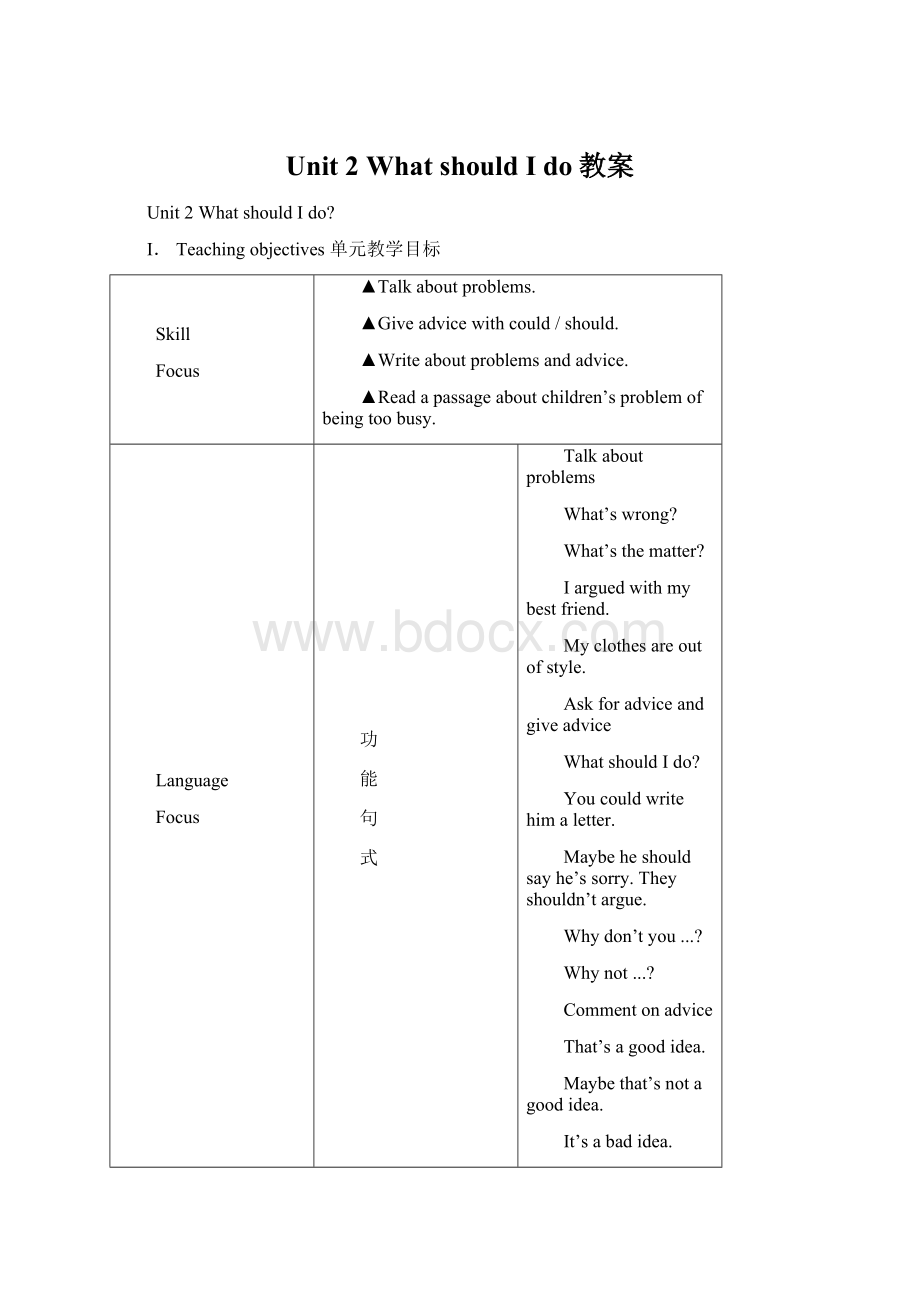 Unit 2 What should I do教案Word格式文档下载.docx
Unit 2 What should I do教案Word格式文档下载.docx
- 文档编号:21286376
- 上传时间:2023-01-29
- 格式:DOCX
- 页数:26
- 大小:61.95KB
Unit 2 What should I do教案Word格式文档下载.docx
《Unit 2 What should I do教案Word格式文档下载.docx》由会员分享,可在线阅读,更多相关《Unit 2 What should I do教案Word格式文档下载.docx(26页珍藏版)》请在冰豆网上搜索。

Askforadviceandgiveadvice
WhatshouldIdo?
Youcouldwritehimaletter.
Maybeheshouldsayhe’ssorry.Theyshouldn’targue.
Whydon’tyou...?
Whynot...?
Commentonadvice
That’sagoodidea.
Maybethat’snotagoodidea.
It’sabadidea.
It’sanokayidea.
词汇
1.重点词汇
play,loud,argue,wrong,could,ticket,surprise,either,except,fail,football,until,fit,include,send,themselves,should
2.认读词汇
style,bake,tutor,original,nicer,haircut,upset,pressure,complain,pushy,compare,crazy,adult,TeenTalk,organized
3.词组
keepout,outofstyle,callsb.up,onthephone,payfor,thesameas,instyle,geton,asmuchaspossible,complainabout,allkindsof,compare...with...,ontheonehand,ontheotherhand
语法
Howtouse“should/could/shouldn’t”togiveadvice
Strategy
Listeningforspecificinformation
Cooperating
II.Teachingmaterialsanalyzingandrearranging教材分析和教材重组
1.教材分析
本单元的话题是“Problemsandadvice"
,通过单元学习,学生不仅能谈论自己生活中的问题,而且能用could和should来提出建议,并对别人提出的建议进行评价;
在掌握功能句式的基础上,要求学生能创造性地应用所学句型,向专栏写信说明自己的问题并寻求建议,另一方面能就别人的问题提出建议,替专栏作者写回复信。
SectionA1a呈现了一些学生日常生活中可能会遇到的问题,让学生根据问题的严重与否进行分类,初步了解一些重要词汇;
1b是一个听力练习,学生听录音然后把听到的问题圈出来,学生通过听一段口语对话了解目标语言:
谈论问题及提出建议;
1c是口语练习,学生结对谈论1a中呈现的问题并提供建议,练习用could和should提建议的功能句型;
2a和2b是听力练习,通过听力活动了解could和should的用法,并进一步掌握givingadvice的功能句式;
2c是一个小组活动,要求学生对上面录音中听到的对话进行角色扮演,口头练习谈论问题及提供建议;
3a呈现了一段和目标语言有关的对话文字,让学生用goodidea,okayidea及badidea对一些建议进行评价;
3b是对3a的口语训练,要求学生既能提出建议,又能对提供的建议进行评价;
4设计了一个情境,要求学生先根据该情境提出建议,并根据所列的建议进行口头会话练习。
SectionB该部分是综合的语言实际运用和知识拓展部分,听力是本单元“谈论问题并给出建议”的实际运用,学生在独立完成的过程中,要体会该语言功能的具体运用。
同时鼓励学生用2a和2b的语言材料来完成2c的对话仿真。
3a和3b是阅读和写作训练,是语言功能的再现和延伸,它为本单元语言知识提供了操练的材料。
在教学过程中,要充分发挥学生的主动性来参与讨论。
Selfcheck1要求学生对所学词汇进行填空和造句练习,检验他们对词汇含义和用法的掌握;
2要求学生阅读一封写给专栏作者寻求建议的信,然后根据信的内容写封回信,给出自己的建议,是对应用目标语言解决实际问题能力的检验。
Reading该阅读文章以英美国家孩子们繁重的学习和课外生活为话题,设计了4个Section:
Section1是阅读的热身,要求学生结合自己的课外生活完成表格,并借助词典了解文章中将出现的生词的意思;
Section2呈现了阅读文章以及阅读策略,阅读策略帮助学生学习用learner’sdictionary学习词汇;
Section3是对阅读效果的检验及语言知识的学习,形式为讨论、生词造句以及写一封建议信;
Section4是阅读内容的延伸,形式为班级调查和角色扮演,培养学生的语言应用能力和解决问题的能力。
2.教材重组和课时分配
Period1(SectionA:
1a,1b,1c)Function
Period2(SectionA:
2a,2b,2c)Grammar
Period3(SectionA:
3a,3b,4)
Readingandspeaking
Period4(SectionB:
1a,1b,2a,2b,2c)
Listeningandspeaking
Period5(SectionB:
3a,3b,3c,4,Selfcheck)
Integratingskills
Period6(Reading:
Section1-Section4)Extensivereading
III.Teachingplansforeachperiod
分课时教案
Period1Function
Targetlanguage目标语言
1.Wordsandexpressions重点词汇和短语
play,loud,argue,wrong,outofstyle,keepout
2.Keysentences重点句子
Maybeyoushouldbuysomenewclothes.
Abilitygoals能力目标
Enablestudentstotalkaboutproblemsandgiveadvicewiththetargetlanguage.
Learningabilitygoals学能目标
Helpstudentslearnhowtogiveadvicewithshouldandcould.
Teachingimportantanddifficultpoints教学重难点
Howtogiveadvicewithcouldandshould.
Teachingaids教具准备
Ataperecorder.
Teachingproceduresandways教学过程与方式
StepIFunctionpresentation
Thisactivityintroducessomenewvocabularyaboutproblemsandthenewfunctionofgivingadvice.
T:
Hello,everyone,I’mverytiredtoday.CanyouguesswhyIamsotiredtoday?
S1:
Ithinkyouworkedveryhardyesterday.
No.
S2:
Ithinkyoureadabookyesterdayeveningtillmidnight.
Oh,no.
S3:
IthinkyouwatchedTVyesterdayevening.
No.BecausethemanupstairsplayedhisCDstooloudandIcouldn’tgotosleep.Doyouhavesuchproblemsinyourlife?
Whatproblemsdoyouhave?
Givestudentsabout2minutestotalkabouttheproblemstheyhaveintheirlife.Thenletthemturn
topage10andlookatactivity1a.
Herearesomeproblemsinactivity1a.Readtheproblemsandtelliftheyareseriousornotserious.Thenputthemintherightcolumnbelow.Thenplaythetape,letstudentslistenandcircletheproblemstheyhearinactivity1a.Thenchecktheanswerandletthemrepeattheproblemsafterthetape.
Intheconversation,agirltalksaboutherproblemsandanothergirlgivesheradvice.Let’slistenandwritedownthesentencesofgivingadvice.
Playthetapeagain,givetimeforstudentstowritedowntheadvice.Stopforanswers.Andplaythetapemoretimesifnecessary.Thenletthemsaythesentencesandwritethemontheboard.
Sentencesofgivingadvice:
Maybeyoucouldgetapart-timejobintheevenings.Youshouldn’targuewithyourparents.
Youshouldtalkaboutyourproblems.
Thenmakeasummaryofthefunctionalstructure.
Lookattheblackboard,whichwordsarecommonlyusedinthesesentences?
Ss:
Should,shouldn’tandcould.
Yes,youareright.Weusethemtogiveadvice.Therearemorestructuresthatwecanusetogiveadvice.I’llwritethemontheboard.
Write“Whydon’tyou...”and“Whynot...”ontheboard.Thenpresentaproblemtothem,andletstudentsgiveadviceusing“should”or“could”.
Atthebeginningoftheclass,Itoldyouaboutmyproblem.MyneighborplayedhisCDtooloudandIcouldn’tsleepwell.Nowcouldyougivemesomeadvice?
Youcouldtalktohimaboutthat.
Maybeyoushouldcallthepolice.
StepIIPairwork
Thenletstudentsworkinpairsandpracticetalkingaboutproblemsandgivingadvice.
Nowwho’dliketoreadtheconversationinactivity1c?
Asktwostudentstoreadthesampleconversationandthenletstudentsmakesimilarconversationswiththeproblemsinactivity1a.
Sampleconversation:
A:
What’swrong?
B:
Iarguedwithmybestfriend.
Maybeyoushouldsaysorrytohim.
Thenletstudentsdomorepracticeaboutgivingadvice.
Instructions:
1.Makeatwo-columnchartontheboardwiththeheadingProblematthetopofcolumn1andtheheadingAdviceatthetopofcolumn2.
2.Dividethewholeclassintotwogroups.LeteachstudentfromgroupAwritesaprobleminthefirstcolumn.
Problems
Advice
3.Thenwritethewordscould,should,andshouldn’tontheboardnexttothechart.ReadtheproblemstotheclassandaskstudentsingroupBtogiveadviceusingthewordsgiven.e.g.
Iarguedwithmybestfriend.WhatshouldIdo?
S:
Youcould/shouldsaysorrytohim.
Orletstudentspracticeinpairslikethat.
Languagetips:
Seriousproblemisaverybadproblem,averybigproblem.
Outofstylemeansnotinfashion.
arguev.todisagreewithsomeoneinwords,ofteninanangryway
arguewithsb.Idon’twanttoarguewithyou.
argueaboutsth.Theywerearguingabout
howtospendthemoney.
stylen.流行、风格
instyle流行的
outofstyle过时的
playv.播放playarecord/CD/tapeetc
StepIII.Homework
Leteachstudentwritesthreeormoreproblemstheyhaveonapieceofpaper.
Period2Grammar
could,should,surprise,callup,onthephone
(Maybe)youcould/should...
Theyshouldn’t...
Enablestudentstoaskforandgiveadvice.
Helpstudentslearnhowtoaskforandgiveadvicewiththetargetlanguage.
Howtotelltheslightdifferencebetween“could”and“should”.
Taperecorder.
StepIRevision
Yesterday,Italkedtomyneighborupstairsabouttheproblem,doyouknowwhathappened?
Hesaidsorrytome.Hetoldmethathewouldn’tdothatagain.Ihadagoodsleeplastnight.Sothankyouforyouradvice.Yesterday,Iaskedyoutowriteyourproblemsonthepaper.NowIwillcollectyourpaper.
Collectthepaper;
choosesomesamplesandreadtheproblemsonebyonetotheclass.Letstudentsgiveadvicebysaying“Maybeheorsheshould/could...”toreviewthetargetlanguage.
Forexample,teacherreads,“ThisFridayismymother’sbirthday,butIdon’thavemoneytobuya
giftforher.”Thenastudentmayofferhis/heradvicelike,“Maybehe/shecouldsingasongforhis/hermother.”
StepIIListening
Thisactivityprovideslisteningpracticeusingthetargetlanguage.
NowyouwillhearaconversationbetweenPeterandafriend.Petertalksabouthisproblemsandhisfriendgiveshimadvice.Listenandcircletheword“could”or“should”youhear.
PlaytherecordingforthefirsttimeandstudentscirclethewordsPeter’sfriendusestogiveadvice.Checktheanswers.Thenplaytherecordingagain,letstudentsrepeatthesentencesofgivingadvice.
Thenmoveontoactivity2b.
Nowlookatthesentencesinactivity2b.Therearetwogroupsofsentences.Thegroupontheleftaresentencesofadvice,andthegroupontherightarereasonsthatPeterdoesn’tliketheadvice.Wewilllistentotherecordingagain,drawlinestomatchtheadvicewiththereasons.
Playtherecordingagain.Thenchecktheanswers.
StepIIIGroupwork
Inthisstep,studentswilldosomeoralpracticewiththetargetlanguage.
Pointtotheexampleinthesampledialogue.Asktwostudentstoreadtheconversationtotheclass.
eg.A:
What’sthematter,Peter?
Maybeyoucouldcallhimup.
Idon’twanttotalkaboutitonthephone.
AskstudentstoroleplaytheconversationbetweenPeterandhisfriendusingthetwosetsofsentencesinactivity2b.
Checktheanswersbycallingondiffe
- 配套讲稿:
如PPT文件的首页显示word图标,表示该PPT已包含配套word讲稿。双击word图标可打开word文档。
- 特殊限制:
部分文档作品中含有的国旗、国徽等图片,仅作为作品整体效果示例展示,禁止商用。设计者仅对作品中独创性部分享有著作权。
- 关 键 词:
- Unit What should do教案 do 教案
 冰豆网所有资源均是用户自行上传分享,仅供网友学习交流,未经上传用户书面授权,请勿作他用。
冰豆网所有资源均是用户自行上传分享,仅供网友学习交流,未经上传用户书面授权,请勿作他用。


 铝散热器项目年度预算报告.docx
铝散热器项目年度预算报告.docx
